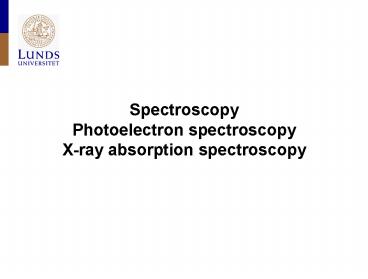Spectroscopy Photoelectron spectroscopy X-ray absorption spectroscopy - PowerPoint PPT Presentation
1 / 15
Title:
Spectroscopy Photoelectron spectroscopy X-ray absorption spectroscopy
Description:
Spectroscopy Photoelectron spectroscopy X-ray absorption spectroscopy Photoemission spectroscopy is surface sensitive X-ray absorption spectroscopy Photoemission ... – PowerPoint PPT presentation
Number of Views:1441
Avg rating:3.0/5.0
Title: Spectroscopy Photoelectron spectroscopy X-ray absorption spectroscopy
1
SpectroscopyPhotoelectron spectroscopyX-ray
absorption spectroscopy
2
X-ray photoelectron spectroscopy
Photoelectron spectroscopy Photoemission
spectroscopy XPS X-ray photoelectron
spectroscopy UPS Ultraviolet photoelectron
spectroscopy
Hard x-ray approx. 1200 250,000 eV Soft
x-rays approx. 20 1200 eV Vacuum
ultraviolet approx. 6 20 eV Ultraviolet appro
x. 3 6 eV
3
X-ray photoelectron spectroscopy
The photoelectric effect (Einstein, 1905)
hv EB Ekin f
4
Core level binding energies characteristic
for the elements
5
A photoelectron spectrum over the
entire available energy range
Secondary electrons electrons which have lost
energy due to scattering on their way out of the
solid into the vacuum
6
Chemical shifts in x-ray photoelectron
spectroscopy
7
Photoemission spectroscopy is surface sensitive
Electrons are extracted only from a thin layer
close to the surface.
X-ray Beam
X-ray penetration depth 1mm. Electrons can be
excited in this entire volume.
1-10 nm
1 mm2
X-ray excitation area can be as large as 1x1
cm2. Electrons are emitted from this entire area
8
The Auger effect (Pierre Auger, 1925)
9
Photon sources
Lab sources photons emitted from an
electronically excited material (lasers, x-ray
anodes, helium lamps) Advantage cheap, can be
used in home Lab, easy to use Disadvantage only
certain energies are available, the intensities
and energy resolution of x-ray tubes are limited
10
Photon sources
Synchrotron light sources Advantages wide
range of energies, high intensity, high
resolution Disadvantages expensive, not readily
available
11
X-ray absorption spectroscopy
XANES X-ray Absorption Near Edge
Structure NEXAFS Near Edge X-ray Absorption
Fine Structure XAS X-ray Absorption Spectroscopy
Unoccupied electronic levels of
atom/molecule/solid
12
How to measure x-ray absorption spectra
13
s and p orbitals
14
(No Transcript)
15
(No Transcript)































